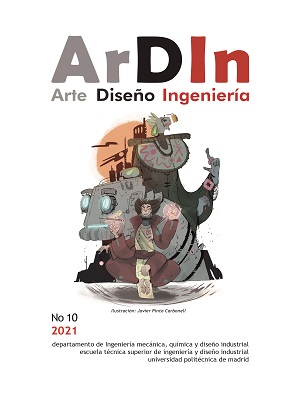Método de dibujo para ampliar y reducir imágenes = Drawing method to enlarge and reduce images
DOI:
https://doi.org/10.20868/ardin.2021.10.4526Keywords:
ampliación, reducción, semejanza, proporción, triangulación, enlargement, reduction, similarity, proportion, triangulationAbstract
Para ampliar o reducir una imagen dada, los métodos utilizados hasta la fecha estaban basados en la homotecia, en el uso práctico de la teoría de la pirámide visual, en operaciones matemáticas a través de la proporción y de una constante numérica, en cuadrículas, en utensilios mecánicos de muy diversa índole o en sistemas fotográficos, de proyección, electrónicos o digitales. El presente estudio desarrolla paso a paso, de manera didáctica y detallada, un nuevo método de ampliación y reducción de cualquier tipo de imágenes, de cualquier forma, de cualquier tamaño, de cualquier formato, en cualquier orientación, en un retorno a lo artesanal frente a los actuales sistemas tecnológicos, sin la necesidad de utilizar números, con el uso exclusivo de simples útiles de dibujo, basado únicamente en la geometría, a través de la proporción y la semejanza de triángulos. Este método puede tener aplicaciones a nivel global, no solo en la pintura de caballete y en el dibujo de estudio, sino también en la pintura mural y el grafiti, y en otros ámbitos que pueden ir desde la jardinería hasta la ingeniería.
Abstract
To enlarge or reduce a given image,the methods used up to now were based on homotecia, on the practical use of the visual pyramid theory, on mathematical operations through proportion and a numerical constant, on grids, on mechanical utensils of very diverse nature or on photographic, projection, electronic or digital systems. The present study develops step by step, in a didactic and detailed way, a new method of enlargement and reduction of any type of images, of any shape, of any size, of any format, in any orientation, in a return to the artisanal facing the current technological systems, without the need to use numbers, with the exclusive use of simple drawing tools, based just on geometry, through the proportion and similarity of triangles. This method can have global applications, not only in easel painting and studio drawing, but also in wall painting and graffiti, and in other areas that can range from gardening to engineering.
Downloads
References
Barbero et al. (2002). Máquinas y herramientas de dibujo. Madrid, España: Cátedra.
Cabezas, L. (2008). El dibujo como invención. Madrid, España: Cátedra.
Ceac (Ed.). (2002). Dibujo y Pintura. Técnicas y Materiales. La perspectiva. Barcelona, España: Ceac.
Da Vinci, L. (2010). Tratado de pintura. Madrid, España: Akal.
Euclides. (1994). Elementos (Libros 5º-9º). Madrid, España: Gredos.
Lawson, P. (1958). Perspectiva para dibujantes. Barcelona, España: Gustavo Gili. Maveco (Ed.). (1987).
Enciclopedia Didáctica de Dibujo y Pintura (Tomo 1). Madrid, España: Maveco.
Szunyoghy, A. (2013). El dibujo del retrato. Potsdam, Alemania: Ullmann.
Ulrich, G. (1974). El mundo de la pintura. Barcelona, España: Círculo de Lectores.
Ubach, T. (Ed.). (2008). El arte del dibujo. Barcelona, España: Parramón.
Downloads
Published
Issue
Section
License
ArDIn does not charge authors for processing or publishing an article and provides immediate Open Access to its content. All content is available free to the user or their institution. Users are permitted to read, download, copy, distribute, print, search or link to the full text of articles, or use them for any other lawful purpose, without prior permission from the publisher or author. This is in accordance with the BOAI definition of open access.
- Authors retain the copyright and grant to the journal the right to a Creative Commons attribution / Non-Commercial / Non-Derivative 4.0 International (CC BY NC ND) License that allows others to share the work with an acknowledgement of authorship and non-commercial use.
- Authors may separately establish additional agreements for the non-exclusive distribution of the version of the work published in the journal (for example, placing it in an institutional repository or publishing it in a book).
Unless otherwise indicated, all contents of the electronic edition are distributed under a Creative Commons license.













